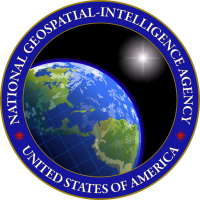It is important that you understand the doctrinal underpinnings of the premier GEOINT organization in the US and perhaps the world.

Required Reading
- Read the NGA (National Geospatial-Intelligence Agency) fact sheet.
- Read NGA Publication 1.0 National System for Geospatial Intelligence: Geospatial Intelligence (GEOINT) Basic Doctrine (STUDY the Introduction on pages 5-6). The reading can be accessed from the Lesson 5 Checklist. As you read NGA Pub 1.0, do some critical thinking and ask yourself:
- Why does NGA define GEOINT as it does and what is NGA's agenda in establishing this definition and its role?
- How does the NGA view differ from Lowenthal's (a CIA type) coverage?
- How might a Geographic Information Science practitioner conducting GEOINT for other than national security purposes (disaster preparedness/response, public health, business intelligence, etc) see the definition and application of GEOINT differently?
- To improve your understanding of the NGA and the strategy it is charged with implementing, scan the NGA 2015 Strategy. The reading can be accessed from the Lesson 5 Checklist.
To get a flavor for the topic, please take a few minutes (4:46 running time) to view Episode Three, Chapter One of the Geospatial Revolution Series.
Video: Geospatial Revolution / Episode Three, Chapter One: Mapping the Road to Peace (4:46)
KEVIN POMFRET: Right now, you can track people with their knowledge or without their knowledge. But, is that really an invasion of privacy or is that just new technology?
MATT O'CONNELL: It's important that we be able to look at any place in the world because if trouble strikes, our government has to deal with the situation.
LETITIA LONG: We are the eyes of our nation, if you will. You need geospatial intelligence to target bad guys.
JAN VAN SICKLE: Mapping to some degree has always been driven by conflict, shall we call or war.
ON-SCREEN TEXT (SET TO MUSIC): In the early 1990s, the Socialist Federal REpublic of Yugoslavia broke apart along ethnic lines. War engulfed the region and the central republic of Bosnia-Herzegovina became a killing field.
UNKNOWN NEWS ANCHOR: In the face of the Bosnian Serb Offensive, another Muslim Enclave Falls. Crisis in the Balkans.
UNKNOWN NEWS ANCHOR: The shelling continued for a second day.
WESLEY K. CLARK: A line of siege was established on the hills around Sarajevo. There are snipers shooting people. Tens of thousands of people were killed.
IRV BUCK: In Bosnia and Herzegovina, we had three separate groups. You had the Croatians. You had enclaves of Serbs. nd you had enclaves those Muslims. It was real mess. Finally, the West decided had to it had to iron this situation out by cutting up the country. So, this is what the Dayton Accords were all about.
IRV BUCK: We had to figure this out so that everybody gets a fair shake here.
ALIJA IZETBEGOVIC: I believe that he did not last for long.
IRV BUCK: And the only way to do that was really geospatially. We brought in this thing called PowerScene. We took digital translation data and we overlaid it with imagery. They have joystick. You can fly over the train. Back down into the valley. We were able to get them to agree that, yes, this is a majority Muslim village, or this is a majority Serb village.
WESLEY K. CLARK: Garage door was an isolated enclave, which was populated by Muslims. The Bosnian Muslims wouldn't give up this piece of ground. They demanded secure access to it. And the question is, where would the lines be drawn.
RICHARD JOHNSON: Eventually the solution was to build a road to open a corridor to them. We used PowerScene to fly a route over the mountains that was far enough away from the Bosnian Serbs that the traffic would not be intercepted or shot at.
JAN VAN SICKLE: We needed a wider corridor. And we had to demonstrate that to the president of Serbia.
WESLEY K. CLARK: Milosevic was smart but he wasn't a field soldier. He never walked that terrain. Well, can't we make this more narrow? Why so many kilometers? Well, you can see right here, Mr. president. Here's the mountain top on one side. Here's the mountain top on the other. You can't draw a line down the side of a hill like this and have it defensible. They have to have the high ground on either side of this valley. He could see this with real terrain. Ultimately, he couldn't beat the argument and we had our road and that's what we needed.
RICHARD JOHNSON: This was the first successful use of deployable digital technology in diplomatic negotiations.
SLOBODAN MILOSEVIC: For the great efforts, the United States invested.
RICHARD JOHNSON: It was hugely satisfying and emotional to know that we helped in the war.
PRESIDENT BILL CLINTON: After nearly four years of 250,000 people killed, the people of Bosnia finally have a chance to turn from the horror of war to the promise of peace.
Then read the NGA fact sheet above and complete the required readings. If you are really enthusiastic, look over Joint Publication 2-03 Geospatial Intelligence Support to Joint Operations (a link to the Optional Reading is provided below).
Optional Reading
Joint Publication 2-03 Geospatial Intelligence Support to Joint Operations (PDF). Recall that NGA is both a DoD combat support agency and a national intelligence agency. Read this article if you are interested in learning more about the role of GEOINT within DoD.
Knowledge Check
Prepare for the quiz by answering the following questions.